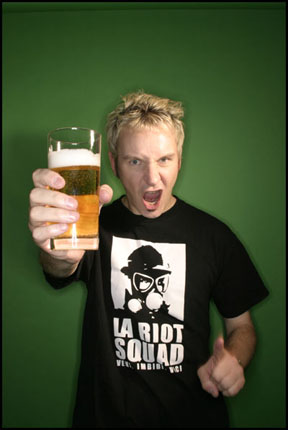
Of all the Galaxy’s supporter groups, the Riot
Squad is the most passionate: a motley and racially diverse crew of club
aficionados
who are more than equal to the emotional and
spiritual requirements Sir Alex Ferguson had invoked at the Coliseum. As
the most
visible and vocal nucleus of support at Galaxy,
the Riot Squad throws some light on the present, and the future, of the
game in the
Southland – and, consequently, the New Soccer
Nation. In Lalas’s opinion, the Riot Squad is “fans like no other – not
better or
worse, just different. And I love ’em.”
Riot Squad lynchpin Tommy Mack moved to Los Angeles
in October 2001 wearing the colors of his club: Dallas Burn. After one
afternoon at the Galaxy, he defected. Anywhere
else in the football-loving world, defection is treason, but there’s no
doubt that the
Galaxy will benefit from Mack’s arrival. “I met
a gentleman named Jeff Skinner,” says Mack, whose constantly bobbing Billy-Idol-blond
hair is a useful point of reference at Galaxy
games. Find the Idol-head, and you’ve found the Riot Squad. “Jeff is more
or less the man
who started it all in motion.”
In cahoots with Skinner, Mack rounded up splinter
groups of dissatisfied Galaxians, the original supporter group, whose numbers
were on the wane. “Some of those people were
at the core of the Riot Squad,” Mack says. “We found a place to watch away
games:
the California Brewing Company in Alhambra.”

The key moment in Riot Squad history came at the
Galaxy’s previous home, the Rose Bowl. “Jeff Skinner made a deal with the
Galaxy’s
front office to take the tarp off one section
so that we would be lower than everyone else – we could stand up and not
upset anyone behind us.
That was the official start of the Riot Squad.
By the way,” Mack adds, “I came up with the name.”
The ethnic makeup of the Riot Squad is the region
in microcosm: “I’m amazed that, if you look at the greater Los Angeles
area,” says Mack,
“the percentages of people in the Riot Squad
are probably the same: Hispanic, Caucasian, black, and Asian. And a few
freakin’ Euros.
And then some idiot from Texas. It’s all over
the field.”
If every soccer fan in Los Angeles possessed Mack’s
24-7 devotion to the game, the U.S. would foam over with soccer nationalism.
He oversees the Riot Squad’s corner of the Home
Depot like the owner of a Greek taverna who’s been refreshing himself with
the
house Ouzo: all comers are welcomed with a bear
hug, a song, and instructions to be present at the next game.
“I really think that to build fan development
you need the sense that you have something to lose,” he says. “You have
to have something
invested into the game, part of your soul as
a fan. The Galaxy, they’re my team, and if they’re losing I’m going to
be there for them,
feel like I’ve had an organ transplanted away
from me and thrown onto a parking lot and splattered.”
There’s the distinct feeling among Mack and his
Riot Squad comrades that match day would be a little more satisfying for
them if the
average homegrown soccer supporter would step
up –shake the Depot with some blind soccer-driven fury; sing the same song
at the
same time, just like they do in Manchester. Sure,
the bank of Korean drummers do their bit, along with the row of masked
South American
percussionists, but the atmosphere could be more
... electric.
Mack celebrates Galaxy goals by darting up and
down the stairs like a cream-faced loon. “Occasionally, we get people who
sit in the Riot
Squad section and don’t realize we’re there and
ask us to sit down,” he says. “I try to warn them. We try not to curse
too much – we’ll say
a few things, you know like ‘suck’ or ‘bitch,’
but we’re not going to have a hundred of us saying: ‘Fuck you.’ There’s
just no point.”
MLS, Mack explains, goes after a family-oriented
atmosphere because the league is so young: “I can see why they’re doing
that. But in
Europe and South America, as soon as you grow
up it’s more of a way of life. Going to a soccer game here is like going
to a movie with
your family.” Mack is right. The experience of
growing up with football in England, for example, is a world removed from
the themed
adventure in slick merchandising and product
placement you find every match day at the Home Depot Center.
Anyone of middling age who attended top-flight
English matches in the late 1970s recalls with pride the widespread lack
of basic amenities.
At a pre-facelift Old Trafford stadium, the gent’s
restroom at halftime adopted a human conveyer-belt system – you joined
at one end, urinated
while shuffling right-to-left, and if you had
not fully answered the call of nature by the end of the porcelain, too
bad. The house beverage was
Bovril, a scalding meat-extract drink not dissimilar
to napalm, and the burger stands were miniature roach coaches. The game
wasn’t exactly
conducive to a family visit in those days, but
discomforts are quickly forgotten when you’re one of 50,000 fanatics singing
the same tune.
The stadia of today’s English Premier League have
thankfully been spruced up, many along slick commercial lines perfected
in the U.S., but the
collective memory of the spit-and-sawdust era
is strong. It’s part of the shared experience of football, part of the
die-hard soul and boundless
energy that mesmerized Charlotte and Diana Grubb
as they stood on the fringes of the pre-game mosh-pit that July afternoon
at the Coliseum.